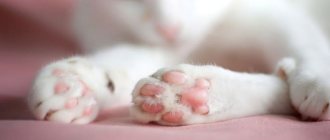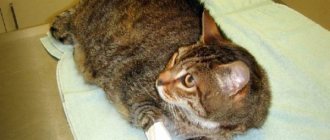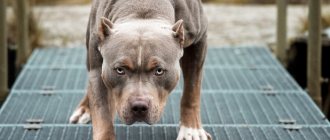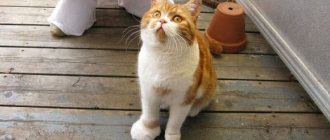A change in gait due to impaired function of the limbs - lameness - is not an independent disease, but a symptom, most often a sign that the animal is in pain. Cats are very active animals, and the sight of a domestic cat limping on a front or back leg often does not cause concern to the owner. However, the causes of lameness are not always harmless, so the owner should know why it can develop and what measures are necessary to eliminate it.
Causes of lameness in cats
Lameness may be temporary or permanent. A cat may limp only in the morning, or after a walk when it is tired. Sometimes this phenomenon disappears on its own, in other cases serious treatment may be required, including surgery.
Causes of lameness can be:
- Injuries.
This is the most common cause of lameness in cats. A bruise received from a fall or a splinter caught in the paw pad cause pain, and the cat will try not to step on the damaged paw. This cause of lameness is usually immediately visible: the paw swells, the cat often licks it and holds it suspended. - Long claws.
A claw embedded in the soft tissue of the paw certainly causes severe pain. - Infectious diseases.
A slight limp or severe lameness can be one of the symptoms of diseases such as chlamydia, calcivirosis, mycoplasmosis. With these diseases, the joints become inflamed and the cat experiences pain. - Lack of microelements.
With a lack of calcium and vitamins A, C, B6 in the diet, bones become more fragile and ligaments less strong, which causes discomfort in the cat when walking. - Hip dysplasia (hip dysplasia)
is a hereditary bone abnormality, most often diagnosed in cats of large breeds - Persian, British, Maine Coons.
- Osteochondrosis.
A typical disease of old cats, osteochondrosis causes pain due to pinching of the nerve roots of the spine. In such cases, the cat may periodically limp on one or both legs (usually the hind legs). - Arthritis, arthrosis, osteomyelitis.
These are diseases that cause inflammatory and degenerative processes in the joints. Lameness is one of their symptoms. Atritis and arthrosis most often affect older cats, osteomyelitis affects individuals under 2 years of age, and Persian cats are at risk for this disease. - Subcutaneous or intramuscular injection
. Often, a cat limps for some time after an injection into a muscle - the administration of a drug or a vaccine. The pain syndrome may persist for several days. - Cancerous bone tumor.
This disease is accompanied by pain in the later stages, when only surgical treatment or symptomatic therapy is possible.
Diseases of the joints and bones
Diseases that affect a cat's joints are often age-related and occur after 6-8 years of life. Some pathologies are congenital and develop gradually; more than a month may pass before the first symptoms appear. Viral diseases and various infections often serve as the impetus for the development of inflammation of joint tissues. If a cat has lameness, the following diseases are possible:
- Hip dysplasia. A genetic abnormality that an animal suffers from birth or has a predisposition to develop. It progresses even at a young age. Lameness in an animal is most noticeable after sleep or rest. When a pet “develops” its limbs after a long period of rest, the symptom is not very pronounced or becomes almost invisible.
- Arthritis and arthrosis. These diseases in most cases occur in older cats and are the most common pathologies affecting the joints. Changes in tissues in both diseases are largely similar, as are the symptoms of their manifestation. The animal tries to move as little as possible - this way the pain practically goes away. The cat refuses to eat and becomes weaker, and sometimes there is a rise in body temperature. Swelling occurs in the joint area, the animal reacts aggressively to palpation, and a local increase in body temperature is felt.
- Patella or luxating kneecap. The pathology is rare and is caused by genetic abnormalities or severe trauma. The disease manifests itself abruptly: the animal suddenly begins to limp, it experiences severe pain, to which the cat reacts by meowing and hissing. Treatment is required as soon as possible, since with further development of the disease, surgical intervention will become necessary.
- Osteomyelitis. The disease most often occurs in cats at a young age during the period of active growth. It is characterized by the process of degeneration of bone tissue and its partial destruction, affecting both one limb and several at once. The disease causes severe pain, so the pet does not allow the affected paws to be touched.
- Osteochondrosis. A disease of the spine, as a result of which the spinal roots are pinched or pinched, causing the cat to lame in various limbs. A failure in the formation of cartilage tissue leads to the abrasion of the cartilage layer between the vertebrae, which causes severe pain when moving. A cat sometimes not only limps on its hind leg, but also pulls it back.
- Osteosarcoma. A malignant formation that occurs in bone tissue. Most often it affects animals over the age of 6 years.
All these diseases are serious and require timely treatment under the supervision of a specialist. Typically therapy consists of painkillers and corticosteroids. In severe cases, surgery is required. If you suspect that your cat is limping due to any of the listed joint diseases, you should immediately contact a veterinary clinic. At home, you can only waste time without proper treatment.
What should the owner do?
The owner of a cat, noticing that the animal is limping, should try to determine the cause of the gait disturbance: examine the paws, feel their soft tissues. In some cases, he can independently provide assistance.
- If a cat is limping after an injection in the thigh, or it looks like he just has a bruise or a sprained tendon, but there is no damage to the soft tissues, the animal should be given a gentle regime for several days. It is recommended not to let him go outside or provoke him into energetic games.
Attention! If a cat’s lameness is severe and clearly accompanied by pain, or does not go away for more than a week, this is a reason to show concern and show the animal to a doctor, regardless of whether the cause of the gait disturbance has been identified.
- If a splinter or other foreign body gets into your paw, you should try to remove it with tweezers, and then treat the area with an antiseptic.
- If it is discovered that the lameness is caused by an overgrown claw, it must be carefully shortened and the cut area filed down.
- If the paw is damaged by a sharp object, the surface of the wound, if necessary, is cleaned of contamination, after which it is also treated with a disinfectant solution. Minor soft tissue injuries usually heal within 2-3 days, and lameness disappears.
- If you suspect that a cat has broken a paw (in this case, the animal does not step on the limb at all, holds the sore paw up or drags it while walking), it is recommended to immobilize the animal or apply a fixing bandage to the paw, and then immediately take the pet to a veterinary clinic. There the cat will be x-rayed and put in a cast.
Attention! If a cat's lameness is severe and clearly accompanied by pain, is very swollen, or does not go away for more than a week, this is a reason to show concern and take the animal to the doctor, regardless of whether the cause of the gait disturbance has been identified.
Prevention
Lameness occurs during normal daily activities. Severe injuries such as falling from a height or being hit by a car can be avoided by keeping your cat indoors.
Cats should eat a carefully balanced diet to ensure a strong and healthy skeleton. If feeding homemade food, consult a veterinary nutritionist who can help you choose the right diet with all the necessary vitamins and minerals for your cat's health.
Avoid obesity in your pet.
At the first sign of lameness on the front legs, consult your veterinarian!
Sources
- https://gafki.ru/koshki/khromaet-na-zadnyuyu-lapu-bez-vidimykh-povrezhdeniy.html
- https://kinpet.ru/u-koshki-otnimayutsya-zadnie-lapy-naskolko-vse-serezno/
- https://vashipitomcy.ru/publ/zdorove/bolezni/khromota_u_koshki_osnovnye_prichiny_provocirujushhie_nedug/15-1-0-1998
- https://animashka.info/koshki-uhod/kotenok-ushib-lapku-hromaet.html
- https://zoostatus.ru/lechenie/simpromy/khromota-u-koshek/
- https://dr-pets.ru/stati/hromota-u-koshek-i-sobak.html
[collapse]
Diagnostics
The success of lameness treatment directly depends on the correct diagnosis and timely use of therapy. During an orthopedic examination of a cat, the veterinarian observes how it walks, stands, sits, and how mobile the joints of its limbs are. It will be determined whether there are painful areas on the paws, swelling, joint abnormalities or areas of elevated temperature.
In difficult cases, additional examinations may be prescribed to clarify the diagnosis:
- Blood and urine tests. They are necessary if infectious or autoimmune diseases are suspected, as well as if the cat is undergoing surgery under anesthesia;
- Biopsy;
- Analysis of the synovial fluid filling the joint cavity;
- X-ray of joints or spinal canal (myelography);
- Ultrasound examination of joints and/or spine;
- Magnetic resonance imaging.
Elbow dysplasia
This disease is not considered the most typical for cats, but... Yes, in the case of outbred “Murks” everything is exactly like that. They practically do not suffer from this pathology; cases are extremely rare. It’s just that in recent years things have been much sadder with purebred cats. The problem is selection. More precisely, in poorly carried out selection: many animals end up in breeding that should not have been allowed there, as a result of which the breed acquires many “bad” genes. The characteristics of the pathology are as follows:
- As is easy to understand, the forelimbs are affected (as a rule, the pathology is well manifested only on one paw).
- The disease is hereditary . If you do not know the breeder, and there are no people among your acquaintances who bought kittens from him, it is better not to take risks. Animals must be purchased only from trusted persons who will not allow sick pets into breeding.
- Elbow dysplasia is diagnosed at the age of two or three years, or even earlier.
- The severity of symptoms varies greatly from cat to cat. Your pet may be lucky, and then he will only be bothered by intermittent claudication, or he may be unlucky, and then without surgery he will not be able to fully move.
Therapy (full) is exclusively surgical . Anti-inflammatory drugs, painkillers, etc. are prescribed only in mild cases when the body’s compensatory reserves have not yet been exhausted. When the cat is already noticeably falling on the sore paw, drug treatment will not give much effect.
Treatment
Therapeutic measures carried out in a clinical setting depend on the identified cause of lameness.
- Dislocation.
The animal is given local anesthesia and the dislocated joint is adjusted, then a fixing bandage is applied. - Fracture.
The cat is given local or general anesthesia if the fracture is open, bone fragments are removed from the wound, and damaged tissue is excised. After this, a plaster cast is applied to the paw. - Hip dysplasia.
The basis of drug therapy is a course of chondroprotectors (Artroglycan, Cosequin, ArthroVet, Joint Max, Stride Plus, Chondartron). If necessary, the cat may be prescribed intra-articular injections of absorbable drugs and/or hyaluronic acid. In severe cases, surgical removal of the femoral head that has lost functionality is used.
- Arthritis, arthrosis, osteomyelitis, osteochondrosis.
Diseases accompanied by degenerative changes in bone tissue require a complex of therapeutic measures. Anti-inflammatory, painkillers, chondroprotectors, vitamins, and mineral supplements are used. Massage and ultraviolet irradiation give good results. - Infectious diseases
. For lameness caused by chlamydia, calcivirosis, mycoplasmosis, therapy is aimed at destroying pathogenic microflora, relieving pain and strengthening the immune system. Tetracycline antibiotics, analgesics, immunomodulators and immunostimulants are used.
In some cases, the cause of lameness cannot be determined. Then the veterinarian will most likely prescribe anti-inflammatory treatment, select a diet high in vitamins, minerals and substances that help strengthen bone and cartilage tissue, and also recommend limiting the cat’s physical activity for a while: keeping it indoors, not allowing it to jump with great height. It is quite possible that such methods will give the desired result, and the lameness will go away.
Why does the animal limp, although there are no visible injuries or obvious causes?
Sometimes it happens that a cat limps from time to time, but there are no visible signs, as well as obvious causes of lameness. In this situation, only a veterinarian can understand why the pet began to limp on the front or back leg. This may be due to diseases of the joints, bone tissue, neoplasms, problems with the spine, and the consequences of infections.











